April 2024: More Lambs, Solar Eclipse, Right Whales
Tuesday April 2 More lambs at Drumlin Farm in Lincoln. Some frolicking around, doing that levitation thing where they leap up off all 4 hooves at once. Lambs head-butting other lambs. One newborn in the pen with its mom, still wobbly on its legs.
The swan is now sitting on the nest at Ward's Pond - I'll be watching to see if the eggs hatch in a few weeks.
Saturday April 6 We've come to St. Johnsbury, Vermont, to watch the total solar eclipse on Monday. First necessity: eclipse t-shirts, from the local Fairbanks Museum and Planetarium.
Franklin Fairbanks, the founder of the museum, was a descendant of Thaddeus Fairbanks, who invented the platform scale here in 1830, commemorated by a historical plaque. His company, Fairbanks Scales Inc., continues to make weighing equipment today. Our motel, the Fairbanks Inn, has small paintings of the original platform scale on each room door.
Sunday April 7 At breakfast, I went out to take a photo of the classic train station across from the restaurant and noticed a welcoming dog sculpture by Stephen Huneck, who lived just outside of St. Johnsbury. You may have seen his doggie art.
After breakfast we went to Dog Mountain, to see Stephen Huneck's gallery and Dog Chapel.
I was taken with the dog stained glass windows and pews.On our way out, I stopped at the restroom and was amused by the dog faucet that turns the water on when you lift its tail.
After our visit, we went to the Lamoille Valley Rail Trail for a walk through the woods. It's the longest rail trail in New England: 93 miles. We heard chickadees and crows, but not much else.
Monday April 8 Eclipse Day! A little after noon, we headed over to Main Street, which the town has closed to traffic. It's a party: excited crowds in the street; booths set up with eclipse information; Vermont Public Radio has a stage set up for scientists to talk about the eclipse; food trucks; drinks and pastries; a stand making kettle corn in a giant metal bin about four feet across. Every public lawn, in front of the museum, in front of each church, is crowded with people in beach chairs, on blankets, some with telescopes, kids running around, dogs happy to be part of whatever it is that is happening. Clear blue sky, not a cloud in sight, and surprisingly warm: we're in our shirtsleeves, enjoying one of the first really warm spring days. Perfect for eclipse viewing.
Around 2:15, it starts: with our eclipse glasses, we watch as the dark shadow of the moon slowly moves across the orange-red disk of the sun. Susan has commented on the amazing coincidence it is that the moon is just the right size to block out the sun at totality - not too small that some of the sun is still visible, and not too large that the corona is blocked out. People around us are talking about this, too.
A few minutes before totality, it gets noticeably cooler and people start putting on their sweatshirts or jackets. Then the sky darkens and the automatic lights on the building across from the church come on. As it gets close to totality, the remaining crescent of sun diminishes to a smaller and smaller bright orange arc, then a point, and then is suddenly gone. In a flash, the silvery corona around the sun is visible. The crowd is elated. Through our binoculars, we see small pinkish red emanences from the surface of the sun; I later learn these are plumes of plasma. The entire thing is amazing.
This is how dark it got during totality:
 |
| 3:29:23pm |
And how quickly it became light again:
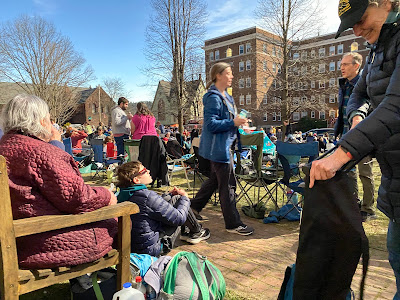 | ||
| 3:30:57 | |
Some photos from Facebook that Susan sent me later on:
and this one, from my hometown of Niagara Falls
Driving to pick up some dinner, we got stuck in traffic on the way back to our motel. Saw two male common
mergansers in the stream beside the road, drifting along with the
current at more or less the same speed as we were driving. Later on, hearing about the 9 hour drives back to Boston that night, we were glad we decided to stay in St. Johnsbury overnight.
Tuesday April 9 On our way home we stopped at the Vermont Institute of Natural Sciences Nature Center, a raptor rehabilitation center. Went to a talk (outdoors) on raptors, featuring a screech owl, broad-winged hawk, peregrine falcon and Harris' hawk. The highlight was the Harris' hawk flying barely a foot or two above the audience, going back and forth between a handler at the front and one at the back. Exciting to see it in action.
We also enjoyed the center's aerial walkway, up among the treetops, with views over a marsh.
 |
| Susan took this one from the top of a tower over the walkway. |
Wednesday April 10 On my morning walk around Jamaica Pond, I spotted a male wood duck standing on a tree branch overhanging the pond, on the south side of the pond. I wondered if there was a female nearby, nesting in a hole in a tree (they are cavity nesters). Coming back home, walking along my street, I heard a flicker calling from a neighbor's roof, then another on the metal cap on my chimney, calling and drumming on the metal cap.
Friday April 12 We went to the Isabella Stewart Gardner Museum to see its spectacular courtyard garden, with the special spring display of nasturtiums, draping down from the third to the first floor of the courtyard in the recreated Italian villa she had built in Boston. Isabella Stewart Gardner (1840-1924), an avid art collector and philanthropist, was "... one of the seven wonders of Boston", as one Boston reporter wrote. Inspired by her stay at the Palazzo Barbaro in Venice, she hired an architect to build a similar palazzo in Boston for her home and to house her growing art collection. She left it all in her will as a museum, with the condition that all the artworks were to be hung as she had them when she lived there.
Sunday April 14 The Arboretum is gorgeous right now: banks of forsythia blooming on one of the hillsides; cherry trees blossoming; daffodils out; and, my favorite, carpets of blue scilla.
Monday April 15 Loved the reflection of the clouds at the pond this morning. I think that the pair of wood ducks at the pond is going to mate. I've seen the male perched pretty high up in a couple of different trees with branches overhanging the water in the past week or so. I'm on the lookout for a hole that they may be using for a nest. Also, two female red-breasted mergansers were at the pond.
Tuesday April 16 Walking around Susan's neighborhood in Cambridge at the end of the day, we stopped by the house of Benjamin Zander, the conductor of the Boston Philharmonic Orchestra, who opens up his garden in the spring, inviting passersby to come into his back yard to take a look.
Thursday April 18 We're in Provincetown for a couple of days hoping to see migrating North Atlantic right whales that have recently been reported in Cape Cod Bay, although not near Provincetown. There are only about 360 left, and of those, only 70 or so are reproductively active females. Each spring, they migrate from their winter feeding grounds off South Carolina and Georgia, where the females calve, to the waters around New England and the Maritimes, passing through the bay.
From the condo, near the beach, we saw groups of red-breasted mergansers, buffleheads, and a single female eider duck diving. Later on in the morning, on our way to look for whales at Herring Cove beach, we stopped at the marina and saw a common loon in breeding plumage; three other loons, too far away to tell if they were non-breeding common or red-throated; more red-breasted mergansers; and about a dozen long-tailed ducks in various plumages - one spiffy non-breeding male, the others in their breeding plumages. Got a good look at their spindly tails, which are nearly as long as their bodies.
At Herring Cove, no whales, but lots of ducks - maybe a hundred eiders, plus several red-breasted mergansers, a few black scoters and I think a couple of surf scoters. We drove on to Race Point to check for whales - no luck. But we did see several Northern gannets plunge-diving, fun to watch their torpedo-like dives.
Driving back just out of Race Point, we spotted a small fox trotting quickly along the edge of the road. As we got closer and slowed down, I noticed that it had some sort of small, dead rodent in its mouth. According to the Mass Audubon website, in Massachusetts, foxes mate from mid-January through February, with a gestation period of 7-8 weeks, so it's possible the fox was carrying its prey back to a den with kits.
Friday April 19 After breakfast, we were looking at the birds in the water near the condo: eiders, red-breasted mergansers etc. Then Susan spotted something further out - dark blobs at the surface, maybe seals. But when I looked, we realized that they were way, way, way too big for seals - they were right whales, surface feeding by the buoy in the harbor. Susan's next door neighbor, Paul, set up his telescope on his deck to get even better views. Four or five whales were hanging around the buoy while several others slowly worked their way over towards the pier in the center of town. Looking up, I saw dozens of gannets flying high over the whales at the buoy, then diving, plunging into the water, going after fish. A really spectacular sight!
A couple of photos from the Center for Coastal Studies, which tracks right whales, and from Facebook:
 |
Later on in the day, at the end of the downtown pier, we ran into a woman with a telescope trained on a single right whale just off the breakwater where the cormorants gather. With the telescope, we could see its huge mouth opening, collecting copepods and other plankton. It's hard to imagine how big their mouths are without seeing one; just their lower jaw is about 14' long. A large fraction of their overall 50' length!
April 22-30 Back in Boston spring is really in high gear: warmer, sunnier weather; magnolias in full blossom; flowers blooming all over - daffodils past peak, tulips starting to bloom; white trilliums out at the Arb; birds singing madly. At the pond, I've been seeing the wood duck pair perching together high up in one tree or another at the south edge of the pond but still haven't spotted their nesting hole. One morning I saw a pair of red-tailed hawks circling high up above the Parkman monument. And there's still a single ruddy duck and a red-breasted merganser hanging around, even though their flocks have migrated north. Mallard ducklings and Canada goslings have appeared.
At Ward's Pond, the swans have piled up yet more reeds on their nest, making it even higher. I saw one of them on the nest one evening, while the other was standing on the tiny bit of beach across the pond, preening. As I walked back to the car, I saw a robin pick up a kleenex on the ground and fly off into a tree, probably to add to its nest.
Friday, April 26 We went to Art in Bloom at the Museum of Fine Arts, with flower arrangements, done by local garden clubs, inspired by the art. Around 45 arrangements throughout the museum, strategically placed to entice visitors to wander through a range of galleries. The place was packed - it's a great way to showcase what the museum has to offer.
Tuesday April 30 My neighbor, Mary, let me know that there was an egret perched on one of the trees on the little island in the pond this evening. Very unusual! They belong in marshes. It was still there when I went to investigate: a great egret.

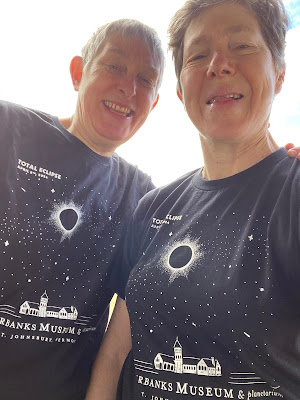
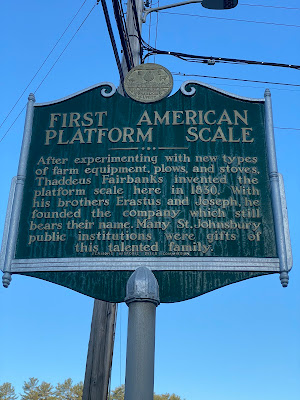










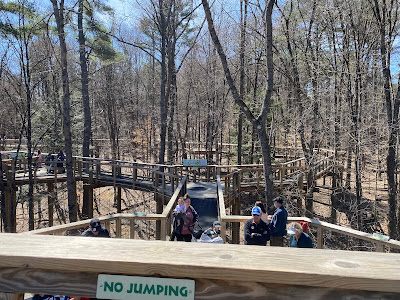



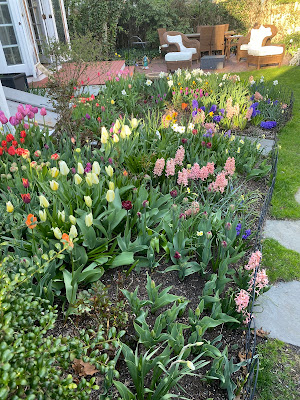


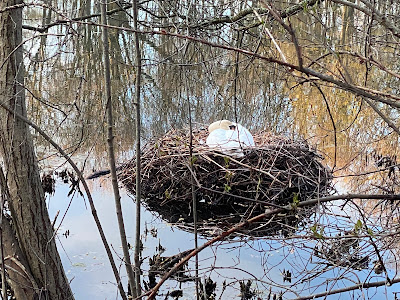






Comments
Post a Comment